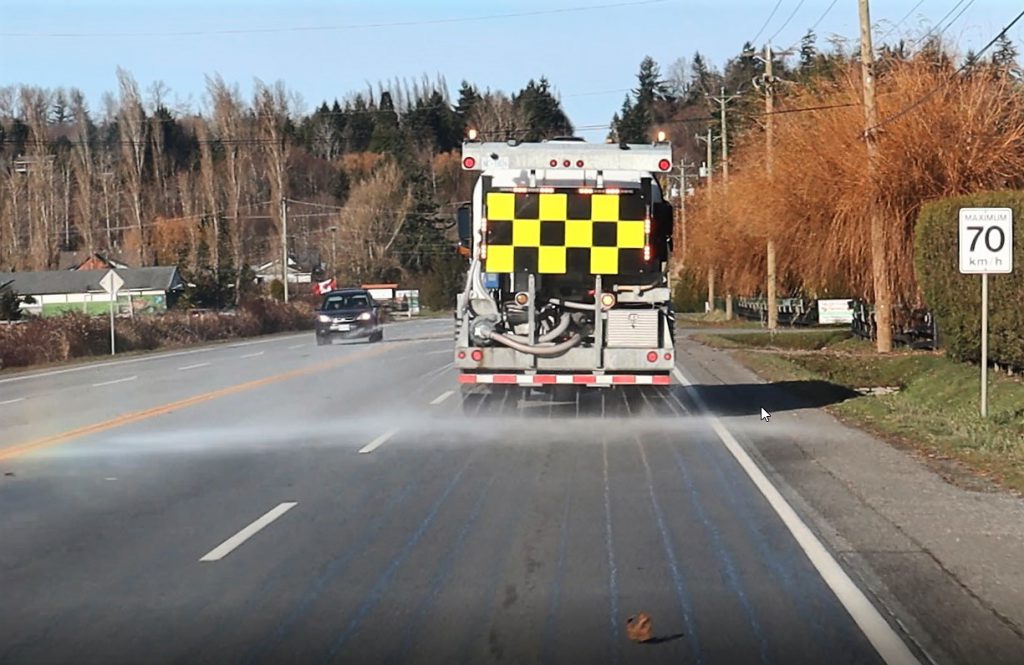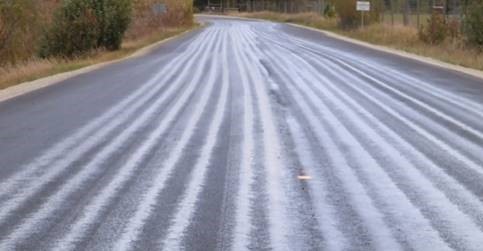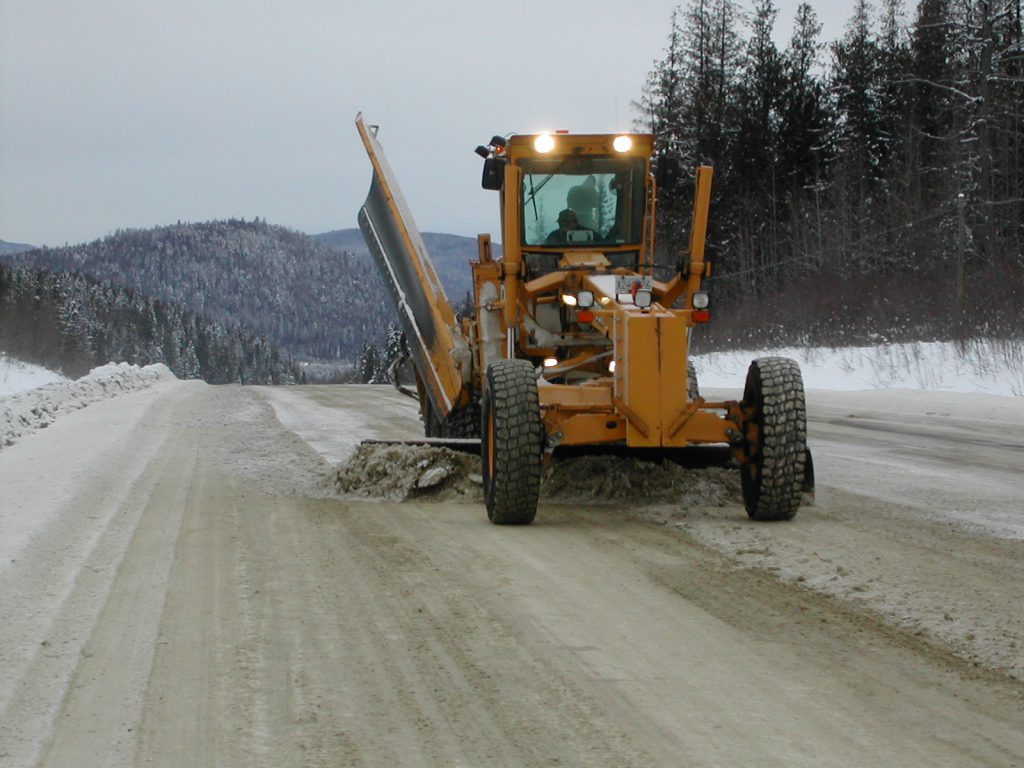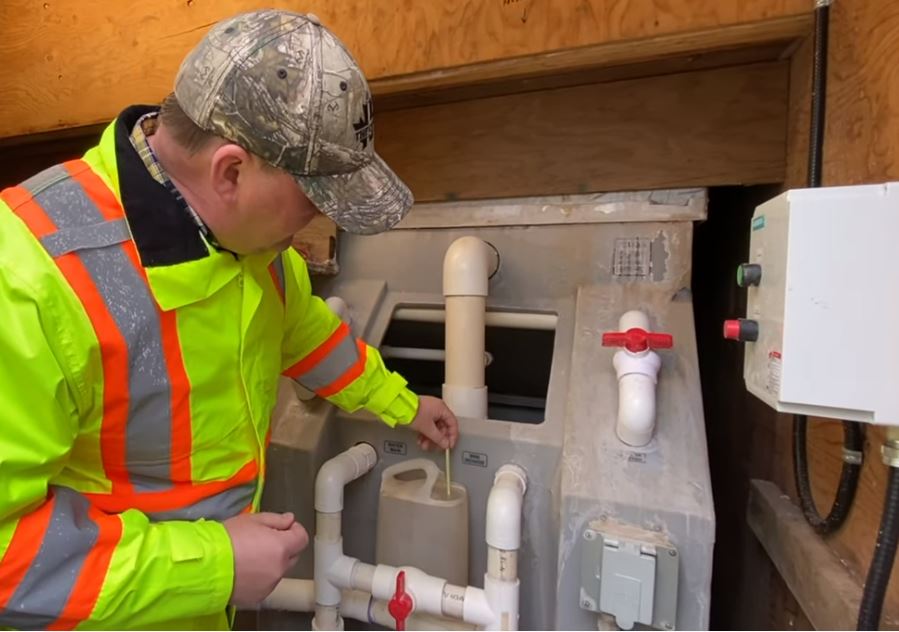
Ice is not nice under vehicle wheels, so our maintenance contractors use brine for anti-icing and de-icing, to help keep highways safe in winter.
Brine is crystal salt (sodium chloride) blended with water – a powerful agent that we draw upon to stop ice from forming on roads, or to transform existing ice and compact snow into liquid. Adding salt lowers the freezing point of water – almost like magic.
Typically the mix, created at a brine making facility, is about 77 per cent water and 23 per cent salt.
Anti-icing – Prevention is our Intention
When the forecast shows a snowstorm is coming, or when the weather is near freezing, or dew or fog could turn to ice, brine is used in a proactive way.
It’s distributed as an anti-icing liquid that prevents snow and ice from forming and bonding to the road. It also softens small accumulations of snow, so that plows can clear the roads to the pavement we all like to drive on.
Anti-icing brine may also be applied as winter is beginning to tighten or loosen its grip – when temperatures are less extreme and humidity is such that dew and fog can form ice. In drier, colder parts of BC, such as the Peace District, it’s more often a shoulder season tool because chillier winter temperatures go below the effective level of brine.

De-Icing – Softening Up Fresh or Compact Snow/Ice
Brine applied to existing snow and ice, makes it easier for plows to remove wintry accumulations from highways and bring the road back to bare and black.
When used as a reactive winter road treatment, it breaks the bond of snow and ice already on the highway and dissolves downward and until it reaches the pavement. Brine effectively melts snow and ice and stops freezing when temperatures are -9 C or warming.
Sometimes, before de-icing, ice blading is done. This puts small indents into compacted snow and ice, helping de-cing agents penetrate to the road.

Once de-icers are applied, a plow may be sent in to finish the job and clear the way. De-icers are not usually expected to clear every bit of ice and snow on the road on the first application. The goal is to keep the roads wet, preventing re-freeze, while our contractors work to remove the ice and snow.
Brine Blends and When to Use Them
Brine can be blended with other chlorides, like calcium or magnesium chloride, in different concentrations for different effects. Some brine blends act faster than others and some work better at lower temperatures.
Each type of chloride has properties to melt ice to a maximum freeze point. However, the closer it gets to that freeze point, the more prone it is to refreezing – which no one wants! Calcium chloride solution has significantly lower freezing point (below -50 C) compared to sodium chloride solution (-20 C).
Our maintenance specifications require contractors to clear highways that are classified as A, B or C, to bare pavement at -9 C or warmer, within specific time frames. Highway maintenance contractors apply brine to compact and ice, and monitor conditions with the aim of staying clear of refreezing. Short timeframes are set out for the contractors, for after they apply de-icing, to remove the slush and broken compact (so it doesn’t return to a hard, slippery, frozen state.)
Summoning data from various weather forecasts, contractors make their winter road treatment decisions based on the best information they have. This includes pavement temperature, air temperature, relative humidity, and the dew point (humidity in the air creates moistures on surfaces like roads). Road temperatures and other atmospheric conditions will dictate what brine solution will be used.
Brine applications are modified through all phases of a storm, based on thorough analyses of forecasted intensity and duration, temperature and type of precipitation.

Maintenance contractors are in the know about what works where, in their service areas.
“The best type of granular level decision-making comes from those who are experienced on the ground,” says Rocky Mountain District Manager Katie Ward. “Every area has micro-climates and local knowledge is extremely helpful, as well as pavement temperature readings and weather forecasts. Most ministry vehicles and maintenance contractor vehicles are equipped to detect road temperatures.”
Why Not Rock Salt ?
Brine is a staple among contractors’ large selection of recognized products to apply to reduce or remove slippery surfaces and keep roads safe and open. Treatments include various liquid anti-icers and de-icers, sand for traction, a sand/solid salt mixture, pre-wetted sand (where de-icing brine is added to sand before or during application), and solid salts.
So why pick (liquid) brine over (solid) rock salt?
It’s about choosing the right tool for the job. Brine works right away, while rock salt which needs time to liquify before it’s effective. Depending on the anticipated forecast, a contractor may choose one tool over the other. Salt brine is more effective at lower temperatures than rock salt, and it stays on the road in dry conditions, whereas rock salt can bounce off or be blown off hard surfaces like ice or pavement. Check out Mainroad Group’s video that outlines these and other benefits of brine over rock salt.
That said, sometimes rock salt – a traditional approach – is put to work. This type of de-icer is most effective when pavement temperatures are -6° C or warming. The solid form can continue working over a longer period of time versus straight liquid. However, well-graded (vs. smooth) compact is necessary to create a surface that enables rock salt to settle in and not get blown away by traffic or wind.
Driver Tip: Wash your vehicle with soap and water after winter storms and at the end of winter, to remove residue from brine, sand and salt. Be sure to spray underneath too!
Winter offers a whole range of weather conditions that can change quickly and make travel tricky. Brine makes ice vanish or keeps it away, to help you move safely on your way.
More about winter maintenance:
- A Look at Winter Maintenance on B.C. Highways (video)
- How BC Highway Maintenance Contracts Have Changed for the Better
- Why are Some Roads Plowed More Than Others?
- Winter Traction – Why Small Rocks, Instead of Sand
- Our Avalanche Crews Know Snow Flow
Tell us what your biggest challenge for winter driving is – snow, freezing rain, slush, ice or…?
Has anyone noticed the widespread tree kill along roads that brine is used on? Seems trees don’t like the spray just like my truck.Big problem that is obvious across the whole country since brine was introduced.
Hi Kootguy,
Is there somewhere in BC, where you have a particular concern? Mountain Pine Beetle sure has taken a great number of our trees, to be sure. 🙁
Using sand on the ice, helps to prevent slippage. we drove Highway 1 on Monday and the Burnaby stretch was like a skating rink.
Hi Pat – thanks for your comment. As this page is monitored during business hours, we ask that if you ever notice anything that causes you concern to please report it directly to the local maintenance contractor for follow up. You can do so by using the Report a Problem feature on DriveBC or by connecting with the contractor on the platforms listed here: https://www2.gov.bc.ca/gov/content/transportation/transportation-infrastructure/contracting-to-transportation/highway-bridge-maintenance/highway-maintenance/contacts#SA01
Brine solution is a joke.. it snows on top of the brine and dilutes it.. then at night or when the temperature drops it turns the roads into a skating rink..
And on top of that this crap rots all your wiring and the underneath of your vehicle.
Go back to salted sand 🤦🏻
Thanks for sharing your opinion with us here, Anonymous.
This doesn’t work at all! All the sprays Just makes the roads very slick and dangerous. How many accidents happen right after you spray? You can’t stop or accelerate! All the roads that aren’t sprayed have way better traction by far. Honestly how can you think using less salt mixed with water is more effective then straight salt?! Has anyone checked on the viscosity of the brine? Just walking on wet slimy mess you slide around. Its like you’re spraying oil.
Hi there Brock – is there an area or a highway which you noticed this? That will help us share your concern forward.
Whoever thought this crap up needs to be bathed in it just like the people who have to work in it!!!!! Can’t see 50’ in front of you at night and how do you wash the black crap off at -10°C ?!?!?!
Hi Blake – sorry to hear your frustration. Regular washing (in colder temperatures an indoor car wash) might work best. Hope this helps!
Is it common practice to have companies like YRB spraying the roads with corrosive salts when there is no snow or ice on them? I have noticed they seem to be able to have the ability to decide when to clear the roads, and when to just drive around spraying product to give the appearance they are using taxpayers money to keep the public safe. Who ensures this is happening? Is there an external audit process or is it internally reviewed by a senior manager who happens to be getting money for the contract regardless? How do we the public ensure that the extensive damage done to our vehicles isn’t a personal cost to us? What do I do about the damage being done to my vehicle each time I drive the highway?
Good morning,
Our maintenance contractors act on the ministry’s behalf to ensure that BC highways are safe for everyone who uses them. Part of their job in that regard, is to proactively prepare roads for inclement weather using brine or salt water applications to prevent roads from becoming slippery due to ice which can form when the temperatures drop. Our contractors are required to follow strict guidelines on road maintenance and we assign ministry staff in each of our service areas the responsibility of monitoring and auditing their performance on a regular and unbiased basis. Our contractors are also responsible for adhering to our environmental guidelines, which we have included a link to below. If you have concerns about damage to your vehicle (that regular washing to remove salt or residue build up won’t take care of), please file a claim with ICBC and once that claim has been approved, you can loop in the ministry’s claims department. I hope that this information is helpful to you.
https://www.tranbc.ca/2020/01/29/how-bc-highway-maintenance-contracts-have-changed-for-the-better/
https://www2.gov.bc.ca/gov/content/transportation/transportation-infrastructure/engineering-standards-guidelines/environmental-management/reference-documents
https://www2.gov.bc.ca/gov/content/transportation/driving-and-cycling/licensing-and-insurance/highway-claims?bcgovtm=20200506_GCPE_AM_COVID_9_NOTIFICATION_BCGOV_BCGOV_EN_BC__NOTIFICATION
How do I submit a resume to you guys
Good morning Randy and thanks for your interest in working with us!
We post our current employment opportunities through the centralized provincial employment opportunities website and encourage you to create a profile and apply on any opportunities that interest you there. Here is the link:
https://www2.gov.bc.ca/gov/content/careers-myhr/job-seekers/current-job-postings
We hope that this is helpful!
What does brine do to the environment, animals and vehicles?
Hi John
Thanks for your question. Our use of brine and salt are governed by our Environmental Best Practices guide and the ministry’s Environmental Management group oversees that the treatments we use are in accordance with federal, provincial and local legislation governing water and wildlife. Here’s a link for more information: https://www2.gov.bc.ca/assets/gov/driving-and-transportation/transportation-infrastructure/engineering-standards-and-guidelines/environment/references/envir_best_practices_manual_complete.pdf